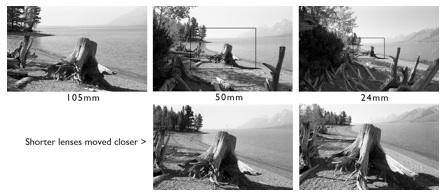It comes as quite a surprise to a lot of the photographers I work with that the only thing that changes when you use a different focal-length lens is the cropping of your image!
Optical aberrations aside, short focal-length, or “wide-angle,” lenses do not distort close subjects, and long focal-length, or telephoto, lenses do not compress subject features. What really causes these familiar effects discussed so often in popular texts is a change of perspective: a change in the camera’s physical position relative to your subject.
When you move in close to a subject, it becomes very large in relation to its background. So, that over-large nose you get with a wide-angle-lens portrait is because you’ve probably moved in very close to the subject in order to fill the frame, and the nose, being closest to the lens, is now very large in relation to the ears. This is a matter of your proximity to the subject and has nothing to do with the lens itself.
When you look at a distant scene through a long focal-length, or telephoto, lens elements in the scene may appear compressed, almost right on top of each other. Once again, this has nothing to do with the lens, but is simply a matter of the tight framing on the subject. If you put the camera down and frame the scene just as tightly with your hands, the elements of the scene will appear as “compressed” as they did through the lens.
What about zoom lenses as opposed to fixed focal-length lenses? Do they help make your choice easier? Well, yes and no. Assuming the optics are up to snuff, a zoom can provide a great deal of convenience – it’s a zillion focal-lengths in one piece of hardware. But that convenience can lead to overly casual, rather than critical, vision. Imagine a photographer out for a walk. He (or she) comes across a detail or a scene that interests him. Camera goes up to eye, hand zooms lens to frame the subject, auto-focus and metering do their jobs, shutter goes click, and it’s on down the path. Would the image have been more powerful if our photographer had moved in close to some boulder in the foreground, making it monolithic in relation to the background? Maybe. Or maybe backing up a bit might have let some tree branches frame the scene.
The point in all this is that to maximize the impact of a visual statement it is important to give thought to the image structure first. Is the composition better closer in? Farther back? Up, down left or right?
Once you pick your camera position, then choose the focal length that gives the cropping you want. If your first guess is too tight, use a shorter lens, if it’s too loose, use a longer lens. If you don’t have a lens that is quite right, use one slightly shorter than you would like and crop. That’s the lens to use!



Nowshad Rahman